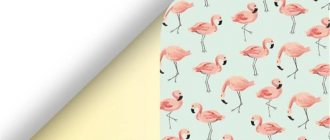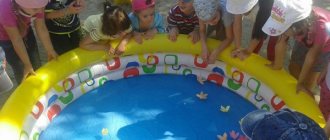Abstract of OOD on the topic: Space for children of the middle group of preschool educational institutions
Types of activities for children: play, communication, cognitive, motor exploration, construction from various materials. Integration of educational spheres: social-communicative, cognitive, linguistic, artistic and aesthetic.
Goal: to expand children’s knowledge about space and space travel, develop children’s artistic creativity, interest in independent creative activity (graphic, constructive model), satisfy children’s needs for self-expression, develop skills of friendly communication and interaction with peers, evoke emotional pleasure in children from activities, activate children's fantasies, form elementary ideas about space and space, encourage active speech.
Preparatory work: training in finger gymnastics “The Stars Are Shining”, the physics protocol “Cosmonauts”; visualization of illustrations in space; conversation on the topic “Cosmonaut”; design made from rocket waste. Expected results: children show interest in creative activities, are kind to each other and to the teacher; have a basic understanding of space and space; actively express your thoughts through speech. Contents of organized children's events
1. Introduction to the game situation
Teacher: Guys, we have guests today. I have to say hello. I say hello everywhere - At home and on the street, Hello too, I say On the next street. Hello, blue sky, hello, golden sun, hello, light breeze, hello, oak tree, hello, morning, hello, day, took the time to say hello Teacher: Children, this morning I received an unusual email. Let's see together. Who knows what? Can we help him?
2. Discovery of new knowledge.
Spatial conversation teacher: Guys, look, this is a space model. And it seems to me that something is missing? What do you know? Children: Stars. Teacher: Okay, guys. Space is a world of stars, it is very diverse. The stars appear small because they are far away. In fact, stars are huge spheres of glowing gas, similar to the Sun. Take each of the stars, let's place them in our spatial diagram. What else is missing? Children of the Sun Teacher: Find the sun. See what a huge sun really is. And the stars seem very small in comparison. Guys, there are unusual balls near the sun. These are planets. I repeat... Nine planets revolve around the Sun, listen to their names: Mercury, Venus, Earth, Mars, Jupiter, Saturn, Uranus, Neptune, Pluto. Look at each planet, they are all different, very beautiful and unusual. Who knows what kind of planets these are? Teacher: What planet do we live on? Children: Earth Teacher: That's right, guys. Why is our planet Earth called the blue planet? Because most of our planet is covered with water: seas and oceans, rivers and lakes.
3. Didactic game “Rocket”.
A minute of physics “Cosmonauts”. Educator: Guys, I don’t know who knows nothing about space but really loves puzzles. But he can't solve the puzzle. Listen. This bird has no wings, but it’s impossible not to be surprised. As soon as the bird straightens its tail, it takes off towards the stars (rocket). Teacher: Guys, you are so experienced in space. I suggest you build a rocket to fly into space, I don’t know based on geometric shapes. Look, we have a model of a rocket. Let's try to build the same rockets. You are wonderful! Let's relax with you. Teacher: One or two, there is a rocket. (boy raises his hands) Three or four, go early. (spreads his arms to the sides) To fly towards the sun (circles his arms) Cosmonauts need a year. (He grabs his cheeks with his hands, shakes his head) But they are not afraid of the road (arms to the sides, body tilts left and right) Each of them is an athlete (bend your elbows) Flight over the ground (spread your arms to your sides) They will greet you. (raises hands and greets)
What else to read: Ecological and psychological training “Robinson Island”
4. Game “Put Dunno Flying”
Teacher: They built a rocket for Dunno, but forgot to pack his luggage. There is nothing superfluous or random in the spaceship. Therefore, during space travel we will take with us only the essentials. I will show you different objects, and you should clap your hands if this item is useful during travel, and hide your hands behind your back if this item is not needed (space suit, sled, bucket, first aid kit, flashlight, doll).
5. Free up space in the bank
Teacher: Guys, I don’t know, now you know a lot about space. And he is ready to become a real astronaut. You and I still don’t have the opportunity to fly into space, we are small. I invite you to create your own space. Bank space. Educator: To give your fingers a rest, let's do finger gymnastics. Stars are shining in the dark sky, an astronaut is flying on a rocket. The day flies and the night flies And looks at the ground. (Alternately connecting the thumb with the little finger, ring finger, middle finger and index finger on stressed syllables.) Children, take a closer look at the table. In front of everyone is an empty jar. I will tell you and show you how to make space in the jar. And you will do this to me. Deal with? Educator: To create space in the jar we will need: stars, cotton wool, a stick and two-color water. Take a cotton pad and divide it into two equal parts. We insert the part into our jar using a stick. Now we take the stars and put them in a jar on cotton wool. Very good. Fill the cotton pad and stars with water from the purple test tube. Now let's do the same. Take the remaining piece of cotton wool and carefully place it with a stick into the jar, put a few stars and fill it with blue water from the second test tube. We close our space well with a lid.
Over the Earth late at night, Just reach out, Grab the stars: they seem close. Teacher: See how well everything went? You are really smart.
6. Summary
Guys, look, another letter has arrived. We see?
I don’t know, he says thank you to us. Guys, what news did we learn today? What is the name of our planet? What is the name of the spacesuit? How many people want to be astronauts? Good guys, you were very careful during the lesson. You will become good astronauts.


